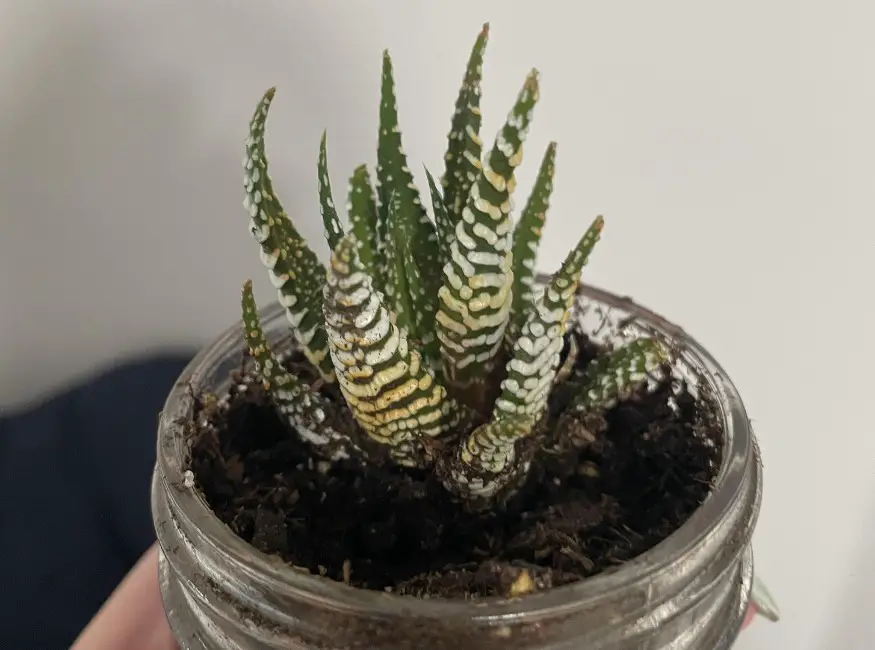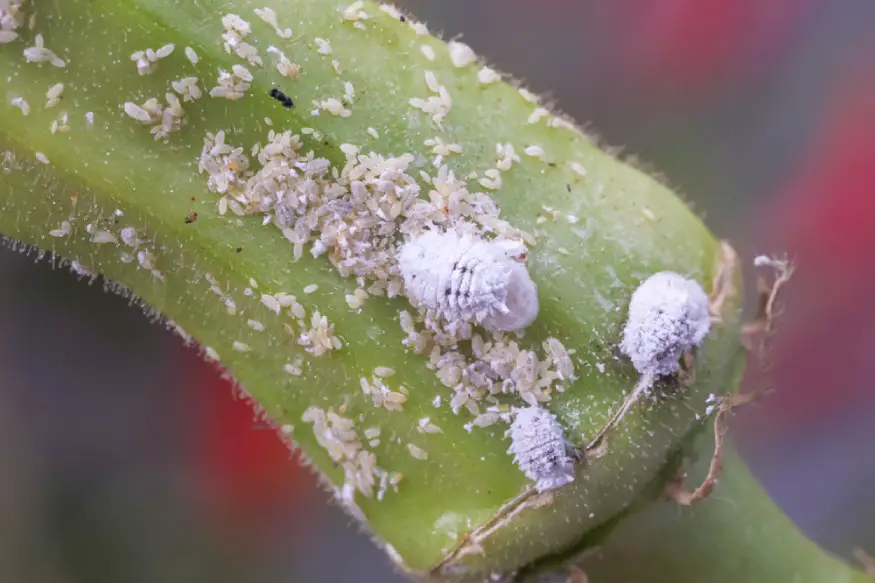Is your zebra cactus looking sick? Maybe it has dead leaves or black spots? Is it Dying?
Don’t despair, there’s hope for your beloved plant yet! In this article, we will go over the common causes of a dying zebra cactus.
By understanding the root of the problem, we can take the necessary steps to revive and save your zebra cactus.
From excess water to lack of sunlight, we’ll cover all the possible reasons behind your cactus’ decline. We’ll also give you tips on identifying these causes so you can take action quickly.
Let’s dive into the first section and explore the causes of a dying zebra cactus.
- Watering Issues: Overwatering causes root rot and mushiness, while underwatering leads to shrinkage and wrinkling. Use the “soak and dry” method for optimal watering.
- Sunlight Requirements: Insufficient light makes the plant pale. It thrives in indirect light near a south-facing window or under grow lights.
- Pests and Diseases: Watch for pests like mealybugs and diseases like root rot. Treat with pesticides or fungicides as needed.
- Repotting Tips: Repot in well-draining soil and a pot with drainage holes if the plant outgrows its current pot or has watering issues.
- Healthy Plant Traits: A healthy Zebra Plant has firm, dark-green leaves with distinct white stripes and a robust, symmetrical appearance.

What a Healthy Haworthia fasciata (Zebra Plant) Looks Like
A healthy Zebra Plant (Haworthia fasciata) typically grows around 4 inches tall and 6 inches wide. It has thick, dark-green leaves that are arranged in a rosette shape. The leaves have white stripes that run horizontally across them, giving the plant its characteristic “zebra” pattern.
These succulent plants typically flower in the late fall or early winter, producing small, white or pink flowers on long stalks.

A healthy Zebra Plant should have firm, plump leaves that are a consistent dark-green color. The white stripes should be crisp and well-defined. The plant should also be growing vigorously, producing new leaves and offsets (small new plants that grow from the base of the main plant).
It’s worth noting that a healthy Zebra Plant may look different depending on the growing conditions, but overall, it should be a robust and sturdy plant with a symmetrical shape, and a consistent and vibrant color.
Causes of a dying zebra cactus
Incorrect Watering practices
One of the most common causes of a dying zebra cactus is improper watering. Both overwatering and underwatering can lead to the demise of your beloved plant.
Overwatering occurs when the soil stays too moist for too long. This can lead to root rot, which is when the roots of the plant begin to decay and can no longer absorb water and nutrients. This in turn can lead to a mushy, discolored cactus that may eventually collapse. Signs of overwatering include yellowing leaves, a mushy texture, and an overall wilting appearance. Additionally, you may notice that the soil is consistently wet or waterlogged.
Underwatering, on the other hand, occurs when the soil is not getting enough water. Cacti are desert plants and are used to living in arid conditions, but they still need a certain amount of water to survive. If the soil is too dry for too long, the cactus will start to shrink and the skin will wrinkle. The cactus will also become light in weight, which is a clear sign of underwatering.
To avoid these watering problems, it is important to understand the watering needs of your zebra cactus. Cacti generally prefer to be watered infrequently, but deeply. A good rule of thumb is to wait until the top inch of soil is dry before watering again. It’s also a good idea to check the drainage of the pot, making sure there are enough drainage holes to allow the water to flow out.
It’s worth noting that the signs of overwatering and underwatering can be similar, so it’s important to pay attention to the plant’s overall health and the conditions it’s being kept in. If you’re unsure, it’s best to consult a professional or do some more research on the specific needs of your zebra cactus.
Lack of Sunlight
Another common cause of a dying zebra cactus is a lack of sunlight. Cacti, like all plants, need sunlight to survive and thrive. Without it, they will not be able to photosynthesize and produce the energy they need to grow and survive.
Zebra plants do not want too much sun. In the wild, they are often found growing under bushes or between tall grasses. Low indirect light is ideal. Like taking care of rhaphidophora tetrasperma, you should avoid harsh direct sunlight, indoors or outdoors.
Proper sun exposure results in a healthy, dark green plant. Overexposure will turn the leaves pale green, and sometimes they develop a reddish tone. If this happens, move your Zebra plant to a location with less light, and it should recover.
It’s also important to note that a lack of light is not the only cause of a cactus appearing pale or yellow, it could also be a sign of pests or diseases, so it’s important to pay attention to the plant’s overall health and the conditions it’s being kept in. If you’re unsure, it’s best to consult a professional or do some more research on the specific needs of your zebra cactus.
Haworthia fasciata Pests and Diseases
Pests and diseases can also be a cause of a dying zebra cactus. These unwanted invaders can cause damage to the plant, which can ultimately lead to its demise.
Common pests that can affect zebra cacti include mealybugs, spider mites, and scale insects. These tiny pests can suck the sap from the plant, causing yellowing and wilting of the leaves, and even black or brown spots on the plant’s skin. Additionally, you may notice a sticky residue on the leaves or stem, which is a sign of a pest infestation.
Diseases can also affect zebra cacti, with the most common being root rot and powdery mildew. Root rot is caused by overwatering and can lead to mushy and discolored roots. Powdery mildew is a fungal disease that appears as a white powdery coating on the leaves and stem.
To prevent pests and diseases, it’s important to practice good cultural care for your cactus, such as providing the right amount of water, light, and fertilizer. Also, it’s important to be on the lookout for signs of pests or diseases and take action immediately if you suspect an issue.
If you suspect that your Haworthia fasciata is infected with pests or diseases, it’s important to take action immediately. You can try to remove pests and diseases by using a pesticide or fungicide, or by physically removing the pests from the plant. However, it’s always best to consult with a professional or do some more research on the specific needs of your zebra cactus and the best way to treat the problem at hand.
How to revive a dying zebra cactus
How to revive your Haworthia fasciata depends on what you have identified is the problem.
I suggest reading our article: How to revive a dying succulent to learn how to revive your plant.
But some of the steps you can take are listed below.
Steps for properly watering the plant
Correctly watering your Zebra haworthia will give it the best chance at survival. You don’t want to cause problems by too frequent watering it, but you also do not want the soil to remain dry for an extended period of time.
Use the “soak and dry” method:
- Place the pot in a sink. You must use a pot with drainage holes in the bottom.
- Gently water the plant until water streams out the bottom.
- Wait a few minutes for the water to absorb throughout the soil as much as possible.
- Drench the soil again to make sure the potting mix is completely saturated.
- Let the pot drain thoroughly.
- Move the plant back to its home.
- Let the potting mix dry fully before watering again.
Tips for providing the right amount of sunlight to Haworthia fasciata
It’s important to make sure your zebra cactus is getting the right amount of light.
A south-facing window with filtered indirect light is ideal, but you should also be aware that direct sunlight can burn the leaves of the cactus, especially during the hottest parts of the day.
If you don’t have access to a south-facing window, you can also use grow lights to supplement the light your cactus is getting.
Dealing With Pests and Diseases

Identifying pests and diseases on a zebra cactus can be challenging, but there are a few techniques that can help.
Spider Mites
One of the most common pests that affect Haworthia fasciata is spider mites. These tiny pests can be difficult to spot, but they can cause damage to the plant by sucking the sap from the leaves. Signs of spider mites include yellow or brown leaves, webbing on the leaves, and small red or brown spots. To identify spider mites, you can use a magnifying glass to inspect the leaves and stem of the plant.
Mealybugs
Another common pest that affects zebra cacti is mealybugs. These pests are small, white, and fluffy and can often be found on the undersides of leaves and in leaf axils. They can cause yellowing and wilting of the leaves, and you may also notice a sticky residue on the leaves or stem.
To treat pests, you can use a pesticide or insecticidal soap to eliminate them. Be sure to follow the instructions on the product and apply it in the evening when the temperature is cooler to avoid burning the leaves.
Powdery Mildrew
When it comes to diseases, one of the most common is powdery mildew. This is a fungal disease that appears as a white powdery coating on the leaves and stem. To treat powdery mildew, you can use a fungicide or a mixture of water and baking soda. Be sure to follow the instructions on the product and apply it in the evening when the temperature is cooler to avoid burning the leaves.
Suggestions for repotting Haworthia fasciata if necessary
Repotting a zebra cactus can be a good solution if the plant is not getting enough water, or if it is outgrowing its current container. Here are some suggestions for repotting a zebra cactus:
- Choose the right container: Zebra cacti prefer containers with drainage holes to allow the excess water to flow out. It’s a good idea to choose a container that is slightly larger than the current one, but not too big, as a cactus can become root-bound if it is planted in a container that is too large.
- Use the right soil: Zebra cacti prefer well-draining soil, so it’s a good idea to use a cactus potting mix. This type of soil is formulated to allow water to flow through quickly, and it also contains elements that are beneficial to cacti, such as perlite, coarse sand, and pumice.
- Water the plant well before repotting: Water the plant well before repotting, to make it easier to remove the plant from its current container. This will also help to reduce the stress on the plant.
- Handle the plant carefully: Zebra cacti have delicate leaves, so it’s important to handle the plant carefully when repotting. Use a spoon or spatula to gently remove the plant from its current container and place it in the new one.
- Provide the right amount of water: After repotting, it’s important to provide the right amount of water to the plant. Cacti generally prefer to be watered infrequently, but deeply. A good rule of thumb is to wait until the top inch of soil is dry before watering again.
By following these suggestions, you can help your zebra cactus to thrive in its new container. It’s important to keep in mind that repotting a cactus can be stressful for the plant, so it’s a good idea to wait a few weeks before fertilizing the plant or moving it to a new location.

